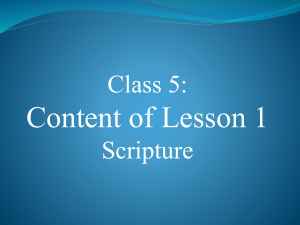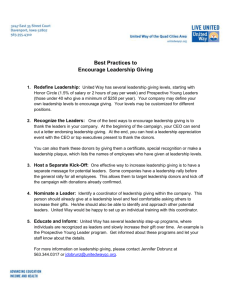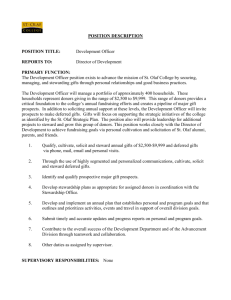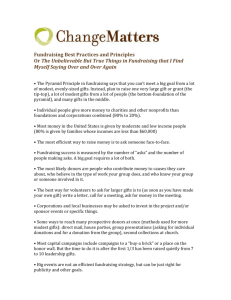Document 12001878
advertisement
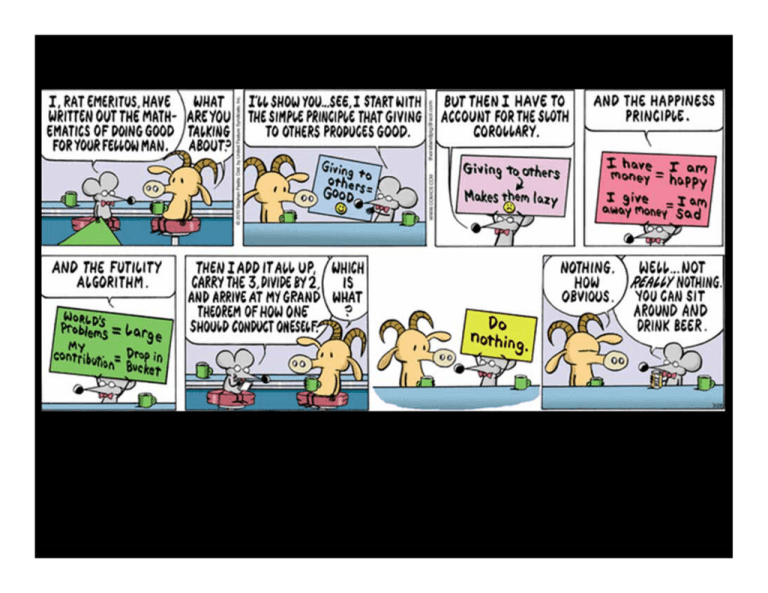
Creating and Using a Strategic Plan by David Allen Developed for Nuts and Bolts of Lake Associations 10 April 2012 ABC Land Conservancy Strategic Plan I. Goals and Objectives A. Raise as much money as possible B. Save the world C. Establish ironclad credibility in the community Strategic Planning Mission Strategy (Direction, Activities) Strategy • Strategies are the set of things you do to accomplish your mission. – Buy land – Host informational meetings – Develop grade school curriculum – Sue the bastards Strategic Planning Mission Strategy (Direction, Activities) Plans (Measurable in Time & Scope) Strategy (Direction, Activities) Planning (Measurable in Time & Donors) Budget Fundraising Goal Plans • Plans show how far you intend to get within a specific period of time – Complete three priority land transactions before Christmas – Host an exotic species workshop in July – Hire an Executive Director in the next three years Mission Strategy (Direction, Activities) Plans (Measurable in Time & Scope) Budget Total expenses less $$ from other revenue sources. Strategic Planning Fundraising Goal Strategy (Direction, Activities) Planning (Measurable in Time & Donors) Budget Non-Gift Revenue • • • • • • Government Grants Interest/Dividend Revenue ‐ Endowment Merchandise Sales Royalties and Leases Registration/Door Fees Raffle Revenue Mission Strategy (Direction, Activities) Plans (Measurable in Time & Scope) Budget Total expenses less $$ from other revenue sources. Strategic Planning Fundraising Goal Strategy (Direction, Activities) Plans (Measurable in Time & Donors) Budget Why do a Strategic Plan? • Thinking and acting strategically is the best way to get the most out of your resources • Helps a group of people understand how their individual actions fit a larger context – establishes buy‐in • Helps the organization say “NO” to distractions Planning Process • Evaluate/Assess what has gone before • Establish or affirm the mission • Brainstorm possible strategies/activities/directions • Choose a set of strategies to work on • Decide how far you plan to get on each one in the given time period, who will take lead responsibility, and how you will measure • Budget appropriate resources Planning Process Evaluate/Assess what has gone before Establish or affirm the mission Brainstorm possible strategies/activities/directions Choose a set of strategies to work on Decide how far you plan to get on each one, who will take lead responsibility, and how you will measure • Budget appropriate resources • • • • • • Do this for your 5‐Year plan • Then do it each year for your annual plans Good Facilitators • Are independent ‐ do not have their own agenda • Help determine a process to accomplish the desired results on time • Guide the chosen process • Ensure participation • Push for specificity • It is possible for a group member to facilitate, but s/he should not try also to participate. Funding Your Activities by David Allen Developed for Nuts and Bolts of Lake Associations 10 April 2012 2010 charitable giving Total = $290.89 billion Giving by source: Percentage of the total by five-year spans, 1971–2010 FREE Executive Summary Download your FREE executive summary of Giving USA 2011 at www.givingusareports.org Trends in Corporate Giving • Corporate Philanthropy is an Oxymoron • Many corporate gifts come from advertising budgets • Exchange relationship is clear • Bang for the buck is important • Visibility to customer base or to employee base is important Trends in Foundation Giving • Foundation giving is often planned years in advance – It’s important to get in the queue • Foundation giving has taken a HUGE hit in recent years, though there are some positive signs for 2012 • Foundation giving is becoming increasingly strategic Why do People Give? 1. What’s being done is worth doing • Belief in the Mission 2. The organization involved can get it done • • • • Fiscal stability Regard for staff leadership Respect for the organization locally Regard for volunteer leadership Definitions: Annual Gifts Annual and Major (Gifts) describes the decision‐making process, not the dollar amount. Annual (periodic) Gifts require little, if any, deliberation by the donor. Definitions: Annual Gifts • Annual expectation (renewal) • General organizational appeal (operations) • Mail or phone solicitation • Quick response • Small(er) gift size • Measure of success = YES Definitions: Major Gifts Major Gifts (stop and think gifts) require consultation, deliberation, and time Definitions: Major Gifts • Specific need • Unique appeal • Personal ask • Multiple visits • Large(r) gift size • Measure of success = ADVANCE Building a Development Plan • Membership (Annual giving) is driven by strategic marketing • Major Gifts are driven by strategic cultivation of current members Planned Giving “If you have left ________ in your will, please let us know so that we may thank you during your lifetime.” Start a Legacy Club 2010 charitable giving Total = $290.89 billion Frames of Reference • Fundraising is about building relationships; only 10% is about “asking” • All Board Members fundraise • You have to give yourself to be effective as a fundraiser • $1,000 is not as much money as it used to be Fifty-Three Ways for Board Members to Raise $1000 by Kim Klein A Word About Donor Files • You need them • Include essential contact info • Copies of everything that comes from THEM – including email and checks • Strategy and cultivation planning Services Call me for: Strategic Planning Development Audit Board Training Board Development Capital Campaigns Major Gift Training fundraisinghelp@sbcglobal.net 608/239‐5006 (cell)
